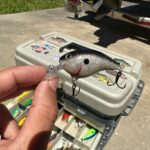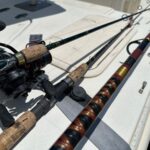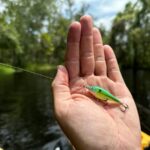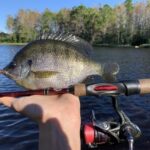Ask any hardcore fisherman, and they will tell you that there is a major difference in the types and styles of fishing line on the market.
Braid…mono…fluoro…high vis…low vis…no stretch…the list goes on and on.
In this article, I’m going to cover a topic many panfish anglers ask: “What is the best fishing line for bluegill?”
And if your like me, and sometimes get ‘thumped‘ by bluegill but can’t seem to hook them…? Well, I’m here to tell you that it could be because you are using the wrong type of fishing line!
This page contains affiliate links. As an Amazon Associate, I earn from qualifying purchases.
Table of Contents
What Kind of Line Should You Use For Bluegill?
Any of the 3 major types of line (mono, fluoro, or braid) are sufficient for catching bluegill, but each line type has its pros and cons. Personal preference and fishing style may help you determine the best choice for your bluegill fishing pursuits.
The best answer to this question is it depends on the style of fishing you are doing.
(I know, I know…but hear me out, and keep reading).
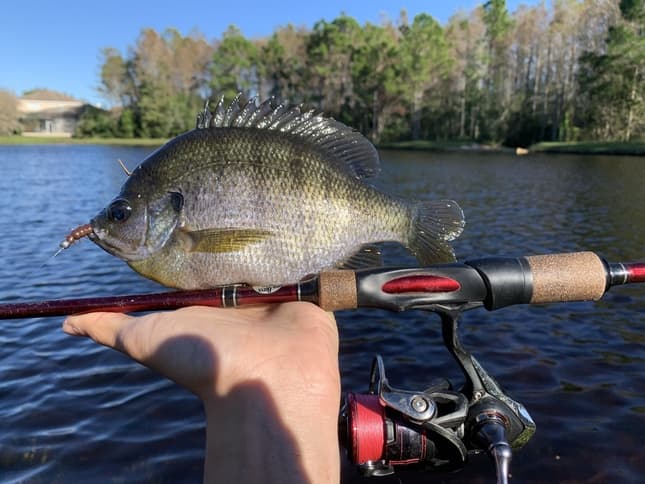
Mono (Monofilament)
Mono has a lot of stretch and is insensitive, so it is best utilized for techniques that do not require lots of sensitivity, such as float fishing or poppers. The stretch of mono also absorbs the force on the line.
The stretch in mono reduces the force of your hook set, but also helps to absorb the force of a strong fish and reduce the chance of them ripping the hooks out.
Check out either the Berkley Trilene Sensation (I use 6 lb test), or Sufix Advance.
For this reason, lure fishing for bluegills with monofilament is ideal with steady retrieve lures such as inline spinners and crankbaits.
Fluorocarbon
Flourocarbon is ideal if you are fishing in very clear water, where fish are line shy, or for techniques that require more sensitivity, such as jigging.
I use Berkley Trilene 100% Fluorocarbon anytime I am fishing in clear water, or when I’m vertical jigging.
Fluorocarbon is denser than mono, so it is a sinking line. This is ideal if you want to help your ultralight bait sink faster without adding more weight.
Braided Line
Due to the braided line’s incredible castability and sensitivity, it is awesome for making long casts, feeling bites, and setting the hook. Braided line is perhaps the most versatile line for any style of fishing because you can tie a mono or fluoro leader to the end of your braid.
You cannot go wrong with the biggest name in braided lines, PowerPro.
I use either the 5lb test or 8lb test in moss green…and I’ve been using them for nearly two decades and they haven’t let me down yet!
Tying leaders gives you many of the advantages of mono or fluoro while keeping the advantages of braid. While some consider braided line overpowered for bluegill, new ultralight braided lines have been making their way into the world of American pan fishing.
What Pound Line Should You Use for Bluegill Fishing?
For bluegill fishing, ideally, your line strength should be less than 8lbs break strength. If you want a challenge, or are dealing with some particularly line shy fish, you could go down to 2lb or 1lb line. However, I believe that anywhere from 2 to 6lb will cover your bases for bluegill fishing.
Bluegill fishing is traditionally done with ultralight tackle, so you’ll want to stay away from lines that are too strong. If you use a line that is too strong, you’ll decrease your ability to cast and retrieve the delicate presentations necessary for bluegill fishing.
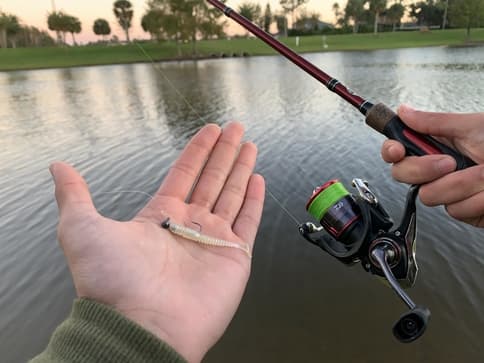
Characteristics of Mono, Fluoro, and Braid
| Characteristics | Monofilament | Fluorocarbon | Braid |
| Buoyancy | Neutral | Sinking | Floating |
| Stretch | High | Moderate | Very low |
| Handling | Supple and easy to cast | Stiff and difficult to cast on spinning reels | Very limp, easy to cast, but susceptible to wind knot |
| Knot Difficulty | Easy | Easy | Difficult |
| Memory | High | High | None |
| Diameter | Moderate 6lb ≈ 0.25mm | Thinner than mono 6lb ≈ 0.22mm | Extremely thin 6lb ≈ 0.06mm |
| Abrasion Resistance | High | High | Low |
| Visibility | Moderate | Low visibility | Highly visible |
| Price | Inexpensive | Moderate to expensive | Moderate to expensive |
Related: High Vis vs Low Vis Fishing Line: Pros & Cons
What is Monofilament?
Monofilament has been around the longest, compared to other types of fishing lines. It is named mono and filament referring to it being composed of just one strand of material, usually Nylon.
Technically, any single-stranded fishing line is a monofilament, but the American fishing industry refers specifically to nylon lines when talking about monofilament or “mono” for short.
Monofilament is tried and true, and it has stood the test of time. It is considered easy to use, all-around good performing, and has a very durable fishing line.
Compared to other types of fishing lines, mono is the most affordable, and it performs well on spinning tackle making it the best fishing line to choose for beginner anglers. For bluegill, I prefer Berkley Trilene.
You May Also Like: How To Keep Bluegill From Swallowing The Hook (3 Easy Tips)
Pros & Cons Of Monofilament
The characteristics of each of these lines are quite different. They each perform differently on the water, but what are the advantages and disadvantages of each line when fishing for bluegill and other small panfish?
First, let’s compare the price. Monofilament is an affordable and widely available fishing line. Braid and fluoro, however, are more expensive, and some premium models can be really pricey. For that reason, mono is a great line to choose for beginners.
However, monofilament has a major disadvantage when compared to the other lines. Mono has high stretch, and this makes it much less sensitive than fluorocarbon or braided fishing lines.
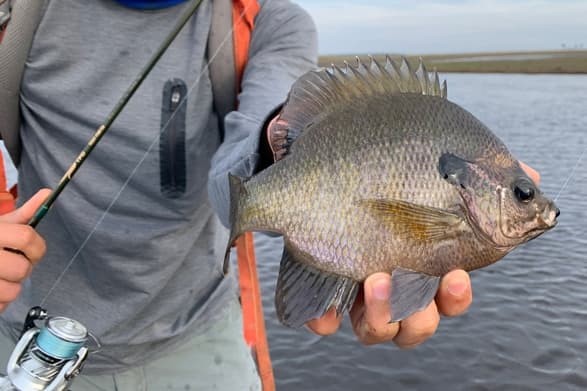
What is Fluorocarbon?
Fluorocarbon is a newer style of fishing line. It was invented in the 1970s by the Japanese fishing line company Seaguar. It is synthesized with a unique chemical compound composed of carbon and fluorine, hence the name fluorocarbon.
Originally, fluorocarbon was used almost exclusively as a leader material in saltwater, but recent improvements have led to its use as a main line in freshwater. It is especially utilized by bass fishermen for finesse applications.
The main advantage of fluorocarbon is its low visibility under the water; it is said to be almost invisible to fish, hence the name of a very popular product, Berkley Vanish.
Pros & Cons Of Fluorocarbon
In more simple terms, light passes through fluorocarbon and water very similarly, so it blends into the water well. If the fish are being line shy, or you are fishing in very clear water, then fluorocarbon has an advantage over mono or braid.
Fluorocarbon is also a lot more sensitive than monofilament. Using fluorocarbon will help to detect light bites and to feel your lure hitting the bottom.
A disadvantage of fluorocarbon is it can be difficult to handle on spinning tackle. Unlike mono, fluorocarbon is stiff, and this makes it difficult to cast, especially with smaller-sized spinning reels.
I made the mistake of putting fluorocarbon on my Piscifun Carbon-X 1000…its an amazing reel, but just too small for the stiffness of fluro.
To counter this effect, many anglers use a larger-sized spinning reel or use a lower-diameter fluorocarbon line. I actually use fluorocarbon on my cane pole. Thanks to its low stretch, I can detect even the smallest bites!
See Also: Choosing The Best Fluorocarbon Line For Baitcasters
What is Braided Fishing Line?
The production of braided fishing lines started in the 1900s, but only recently have they started making their way to conventional fishing methods. A braided line is a multifilament line, so there are many strands woven together into one line.
Most braided lines are rough and abrasive, but they are advantageous for their extremely low diameter and high breaking strain. Braided lines have almost no stretch making them incredibly sensitive.

Some premium braided lines are made to be smoother and thinner than others, like Daiwa’s J-Braid X8. This braided line, in 6lb test, is another good braid option for bluegill fishing.
Pros and Cons of Braid
Braided lines are sometimes known as super lines because they have incredible strength and very low diameter. Most braided lines are over 50% thinner than mono or fluoro when compared at equivalent break strains.
Due to its incredibly low diameter, braid casts further than equivalent strength mono or fluoro. Braid also has almost no stretch, so this makes it super sensitive and powerful. It is even more sensitive than fluoro. These are incredible advantages, but there are some drawbacks.
Braid is not clear like mono or fluoro, so fish can easily see it in the water. Also, due to its low diameter, braided line is very tricky to tie knots with, and many knots that work well with mono or fluoro, need to be modified to work well with a braid.
Braided fishing line also has very low abrasion resistance, so if you’re fishing around rough structures, like bridge pilings or submerged trees, you may break off if your line rubs the structure.
Another disadvantage of braided lines on spinning reels is that braided line is prone to wind knots, due to their extremely low diameter. Wind knots are sometimes unavoidable, but they can be greatly reduced by paying close attention to the line lay on your spool.
Conclusion
To answer the question of what type of line you should use for bluegill, ask yourself what kind of fishing (tactic or technique) will you be doing?
For example, if I am throwing a search lure such as a miniature crankbait trying to find suspended bluegill, I will often use a braided line. I can cast it far, and it’s very sensitive.
If I am fishing in the crystal clear water of the Wacissa River, ill use a fluorocarbon line.
And if I’m just pond hopping, using a variety of baits and lures just having some fun, ill use monofilament.
Hope this helps and good luck!
You May Also Like: Lures for Bluegill- The Top 10 Best of All Time
If you haven’t guessed yet, I love fishing and everything about it!
To learn more about why I started Panfish Nation, visit the About page and follow along on Social Media:


Download a copy of my FREE Lure Color Selection Chart & Knot Guide!
Stay up to date with fishing reports, tackle reviews, industry news, and much more! We respect your privacy, unsubscribe at any time.
Related Posts
- What Size Hooks for Smallmouth Bass? Quick Guide
- Large and in Charge-Mouth: 10 of the Best Bass Lures of All Time (And Where to Buy Them)
- The Seven Best Lures for Fall Bass Fishing
- Which Fishing Line is Best for Bass Fishing With A Spinning Reel?
- What Size Hooks for Panfish?
- What Is The Best Fishing Line For Bluegill?



